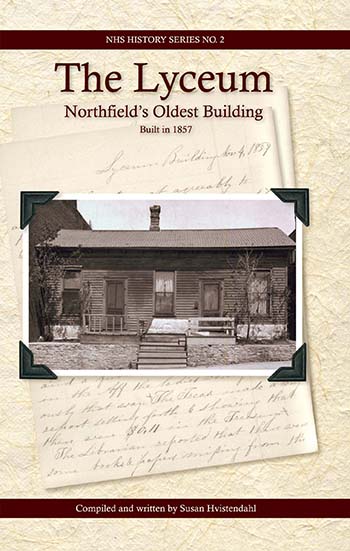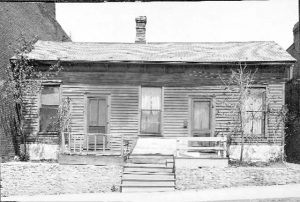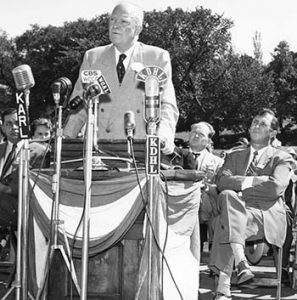Researching historic happenings can be time-consuming. It can also be as easy as “googling” a topic on a computer. Occasionally, it is a matter of serendipitous finds on a library shelf. In 1986, when I was a free-lance writer in New York, I ran across a book on local history published in 1963 in Peekskill which included an essay by Nelson Craven. Craven decried “all the historic materials of incalculable value” that have been “stashed away in old trunks” and are “finally given away or thrown out because they are of no interest to the owners.” He wrote that he had inherited 17 old trunks from his aunt which only he had cared anything about.
I visited Craven, who still lived in Peekskill, and found he had a treasure trove of history in his attic. The trunks had belonged to William Nelson, a Peekskill attorney who had served in Congress with Abraham Lincoln. For 40 years, Craven had been poking through these trunks (contents damaged by rats and moisture) but had not thought to share the findings which included letters from Lincoln, Millard Fillmore and editor Horace Greeley and valuable old deeds, maps, pictures and postcards. I brought in local librarians to help Craven preserve these papers properly and he allowed them to make copies of everything.
When I started writing “Historic Happenings” for the Northfield Entertainment Guide in 2007, I naturally gravitated to the reference room of the Northfield Public Library for inspiration. Time and time again I would look at a big, fat, loose-leaf binder titled “Early Northfield History,” which was composed of clippings from newspapers, programs and personal correspondence related to Northfield’s past. I was told that it was from scrapbooks of Mrs. Charles A. Bierman, which had been donated sometime after her death in 1939. Mrs. Bierman was considered to be Northfield’s unofficial historian and she came to be a most valuable source of information for me, especially for a recent project.

In May of 2009, I wrote a column about “Northfield’s Oldest Building: The Lyceum.” This topic was chosen to be the second in the Northfield History Series, which is funded as a memorial to Barbara A. Will, past president of the Northfield Historical Society, from her family. I began work on the book in the summer of 2009 and it was published last month by the Historical Society.
John Wesley North founded Northfield in 1855 and within a year was holding meetings at the schoolhouse to establish a Lyceum Society for debates, lectures, a reading room and library. By November of 1857, the Lyceum Building at 109 E. 4th St. was built on land provided by North and was home to the society until it waned with the onset of the Civil War. (Most recently, the Lyceum Building has been owned by Dr. Elvin Heiberg, Agu and Mary Lukk and now James H. Johnson and Mary Kathleen Fransen.)

In the course of my research, I discovered I owed a debt of gratitude to Mrs. Bierman because her dedication to history had helped preserve the minutes of the Lyceum Society. The minutes book had turned up among the papers of Owen Meade, a city justice with an office in the Scriver Building, and the book was given to Mrs. Bierman by his daughter, Mrs. George A. Budd, for safekeeping. After Mrs. Bierman’s death, the minutes ended up in the hands of Northfield News editor, Carl Weicht, who donated the book to the Rice County Historical Society in 1942 when he entered the Army.
The minutes bring early Northfield back to life, showing the intellectually engaged pioneers interacting with each other about the issues of the day. The topic at the fourth meeting, Oct. 22, 1856, was “Resolved that woman is entitled to all the social and political rights enjoyed by man” and, as recorded in the minutes, “the society with the assistance of the ladies decided the question in the affirmative.” Hiram Scriver, the town’s leading merchant and active Lyceum participant, later said it was difficult to find anybody to take the negative, “for the male sex especially felt that the great necessity of the house was for the immigration of the fairer sex. Young men and bachelors, therefore, were spoiling to have women vote, and every inducement was offered to get them here.” Scriver noted, “The long winter evenings were spent in debate, music, readings, original papers, etc. Time hung heavy; money and girls, two prime necessities of life, were scarce.”
Among the other affirmative votes at Lyceum debates: “dancing is a proper amusement for young persons,” “war is never, under any circumstances, justifiable,” “the dissolution of the American Union would be preferable to the extension of slavery” and “the pulpit has done more for civilization than the press.” Among negative votes: “religious creeds have been productive of more evil than good,” “the practice of virtue is natural to man,” and “it is morally wrong for the members of this association to neglect to speak at its meetings.”

Songs from a choir were part of the weekly meetings and one entry in the minutes (perhaps foreshadowing the future) read, “This choir reflects great credit on the musical ability of Northfield.” At another meeting, it was suggested the president furnish a song, but he was “excused under the plea that his feelings would not admit of his inflicting unnecessary pain upon his fellow creatures.”
A transcription of the minutes, along with a microfilm of the original book, can be found at the Northfield Public Library. My early interest in Mrs. Bierman’s scrapbooks at the library was rewarded further when I realized that among the items that were saved were submissions to the Lyceum Society’s newspaper, called the Portfolio. This paper debuted on Feb. 16, 1858, and was described in the minutes as “a very spicy and well written sheet.” The ladies of the Lyceum were the “editresses” and, according to a story in the Rice County Journal on Feb. 23, 1882, “articles were published on all subjects, theological, political and financial” and were read to much acclaim at the meetings. Unfortunately, only five articles have survived and only one author is identified – Hiram Scriver, in a humorous piece about an increase in laundry fees.
In my book, excerpts from these Portfolio entries are printed for the first time since they were read at Lyceum meetings in the 1850s. Here is a sample on the topic “Tobacco”: “We have somewhere seen it stated that New York expends daily for cigars $10,000 while the amount expended for bread is only $8,500. Think of it you who use the weed. – Here are $1500 dollars a day more for cigars than for bread. Wherever we go, the cry ‘hard times, o hard times,’ rings in our ears and some say that it is ‘woman’s extravagance and folly’ causing the ruin of the prosperity of the country. But does woman smoke these cigars and where does she have her club-rooms and billiard tables? Where does woman drink her glasses of claret and champagne? … Do not the indulgences and foibles of the stronger sex bear their share in the grand ruin?”
The writer (obviously a female) then “respectfully suggests” that “they had better lift the beam from their own eyes, then they will see more clearly to remove the mite which is in ours.”

Another serendipitous find incorporated into the book were letters from John and Ann North. The Norths had lived in St. Anthony prior to founding Northfield and had been neighbors there of Ard Godfrey, whose house is maintained by the Women’s Club of Minneapolis. In the early 1990s, two ladies who were volunteers with the Godfrey House, Carol McPheeters and Alice Larsen, began transcribing and annotating North letters, which were available on microfilm at the Minnesota Historical Society. They started with the letters written during the St. Anthony years but “by that time, we were hooked and wanted to continue,” as Carol McPheeters told me. So the ladies kept on and came up with a total of 183 letters written to Ann’s family in New York during the years the Norths were in Northfield, 1855-1861. The Northfield Historical Society was allowed to copy these transcriptions for the NHS archives, which will be a lasting legacy of the Lyceum book project.
On Dec. 9, during Winter Walk, there will be a book signing for both books of the Northfield History Series: No. 1, Pioneer Women: Voices of Northfield’s Frontier, edited by Jeff Sauve and recent winner of a Minnesota History Award from the Minnesota Alliance of Local History Museums and No. 2, The Lyceum: Northfield’s Oldest Building. Come to Winter Walk and stop by the Northfield Historical Society at 408 S. Division St. from 6 to 9 p.m. to celebrate “historic happenings” with us.






